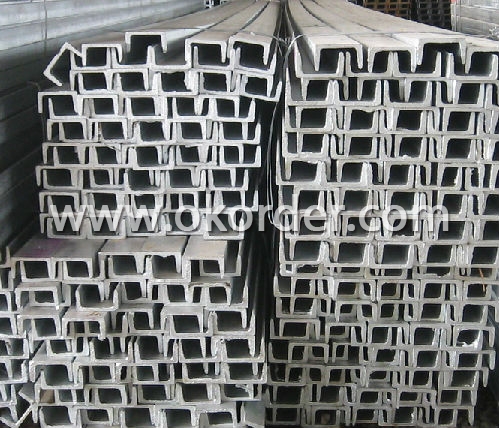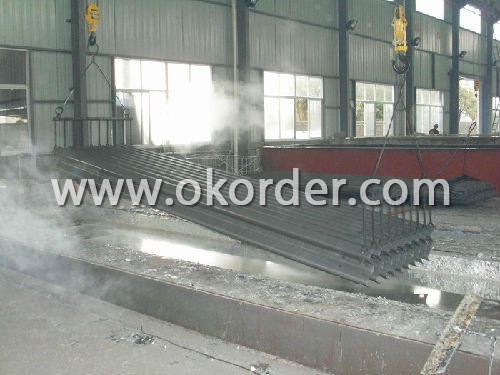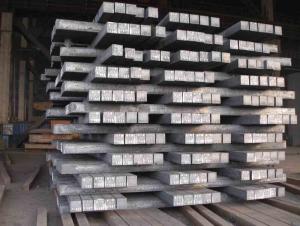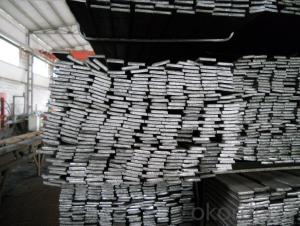100mm*50mm U channel steel for construction
- Loading Port:
- Tianjin
- Payment Terms:
- TT or LC
- Min Order Qty:
- 25 m.t.
- Supply Capability:
- 100000 m.t./month
OKorder Service Pledge
OKorder Financial Service
You Might Also Like
Product Description:
OKorder is offering 100mm*50mm U channel steel for construction at great prices with worldwide shipping. Our supplier is a world-class manufacturer of steel, with our products utilized the world over. OKorder annually supplies products to European, North American and Asian markets. We provide quotations within 24 hours of receiving an inquiry and guarantee competitive prices.
Product Applications:
100mm*50mm U channel steel are ideal for structural applications and are widely used in the construction of buildings and bridges, and the manufacturing, petrochemical, and transportation industries.
Product Advantages:
OKorder's U channel steel are durable, strong, and resist corrosion.
Main Product Features:
· Premium quality
· Prompt delivery & seaworthy packing (30 days after receiving deposit)
· Corrosion resistance
· Can be recycled and reused
· Mill test certification
· Professional Service
· Competitive pricing
Product Specifications:
Galvanized Channel Steel
1. Professional factory
2. Size: 50MM-400MM
3. Standard: GB,JIS,ASTM
4. Materials: Q235,SS400,A36..
A Hot Dip Galvanized U channel coating is relatively easier and cheaper to specify than an organic paint coating of equivalent corrosion protection performance. The British, European and International standard for Hot Dip Galvanizing is BS EN ISO 1461 which specifies a minimum coating thickness to be applied to steel in relation to the steels section thickness e.g. a steel fabrication with a section size thicker than 6 mm shall have a minimum galvanized coating thickness of 85 µm.
Further performance and design information for galvanizing can be found in BS EN ISO 14713-1 AND BS EN ISO 14713-2. The durability performance of a galvanized coating depends solely on the corrosion rate of the environment in which it is placed. Corrosion rates for different environments can be found in BS EN ISO 14713-1 where typical corrosion rates are given with a description of the environment in which the steel would be used.


Galvanized Steel Channel | (mm) | (mm) | (mm) | (mm) |
|
50x25 | 50 | 25 | 3.0 | 6.00 | 2.37 |
75X40 | 75 | 40 | 3.8 | 7.00 | 5.30 |
75X40 | 75 | 40 | 4.0 | 7.00 | 5.60 |
75X40 | 75 | 40 | 4.5 | 7.00 | 5.85 |
75X40 | 75 | 40 | 5.0 | 7.00 | 6.92 |
|
|
|
|
|
|
100X50 | 100 | 50 | 3.8 | 6.00 | 7.30 |
100X50 | 100 | 50 | 4.2 | 6.00 | 8.03 |
100X50 | 100 | 50 | 4.5 | 7.50 | 8.97 |
100X50 | 100 | 50 | 5.0 | 7.50 | 9.36 |
|
|
|
|
|
|
125X65 | 125 | 65 | 5.2 | 6.80 | 11.66 |
125X65 | 125 | 65 | 5.3 | 6.80 | 12.17 |
125X65 | 125 | 65 | 5.5 | 8.00 | 12.91 |
125X65 | 125 | 65 | 6.0 | 8.00 | 13.40 |
|
|
|
|
|
|
150x75 | 150 | 75 | 5.5 | 7.30 | 14.66 |
150x75 | 150 | 75 | 5.7 | 10.00 | 16.71 |
150x75 | 150 | 75 | 6.0 | 10.00 | 17.90 |
150x75 | 150 | 75 | 6.5 | 10.00 | 18.60 |
150x75 | 150 | 75 | 6.5 | 10.00 | 24.00 |
|
|
|
|
|
|
200X80 | 200 | 80 | 7.5 | 11.00 | 24.60 |
2. The Mechanical property of Galvanized Steel Channel:
Grade | Yield Strength,N/mm² | Extension Strength N/mm² | |||
Thickness of Steel,mm | |||||
≦16 | >16-≦40 | >40-≦100 | >100 | ||
SS330 | ≧205 | ≧195 | ≧175 | ≧165 | 330-430 |
SS400 | ≧245 | ≧235 | ≧215 | ≧205 | 400-510 |
SS490 | ≧285 | ≧275 | ≧255 | ≧245 | 490-610 |
SS540 | ≧400 | ≧390 | - | - | ≧540 |
3. The chemical composition of Galvanized Steel Channel
Grade | Element(%) | |||
C | Mn | P | S | |
SS330 | -- | -- | ≦0.050 | ≦0.050 |
SS400 | ||||
SS490 | ||||
SS540 | ≦0.30 | ≦1.60 | ≦0.040 | ≦0.040 |
Usage of Galvanized Steel Channel:


Applications: Galvanized for outdoor use or exposed evironments. Walkways, Ramps, Structural support
The process of hot-dip galvanizing results in a metallurgical bond between zinc and steel with a series of distinct iron-zinc alloys. The resulting coated steel can be used in much the same way as uncoated.
A typical hot-dip galvanizing line operates as follows:
Steel is cleaned using a caustic solution. This removes oil/grease, dirt, and paint.
The caustic cleaning solution is rinsed off.
The steel is pickled in an acidic solution to remove mill scale.
The pickling solution is rinsed off.
A flux, often zinc ammonium chloride is applied to the steel to inhibit oxidation of the cleaned surface upon exposure to air. The flux is allowed to dry on the steel and aids in the process of the liquid zinc wetting and adhering to the steel.
The steel is dipped into the molten zinc bath and held there until the temperature of the steel equilibrates with that of the bath.
The steel is cooled in a quench tank to reduce its temperature and inhibit undesirable reactions of the newly formed coating with the atmosphere
Package & Delivery of Galvanized Steel Channel:
1.The channel steel will be packed in bundle with steel wire at each end of every bundle and color marking in order to help the customer to recognize his goods more easily at sight.
2. And the channel steel could be loaded into 20ft or 40ft container, or by bulk cargo.If the weight of each bundle reaches more than 3.5 mt, the loading by break bulk cargo should be choosed.When the weight of each bundle reaches less than 3mt, the loading by container should be choosed.
3.As for the transportaion from mill to loading port, the truck will be usually used. And the maximum quantity for each truck is 40mt.
4.All in all, we could do in accordance with customer's request.
FAQ:
Q1: How do we guarantee the quality of our products?
A1: We have established an advanced quality management system which conducts strict quality tests at every step, from raw materials to the final product. At the same time, we provide extensive follow-up service assurances as required.
Q2: Can stainless steel rust?
A2: Stainless does not "rust" as you think of regular steel rusting with a red oxide on the surface that flakes off. If you see red rust it is probably due to some iron particles that have contaminated the surface of the stainless steel and it is these iron particles that are rusting. Look at the source of the rusting and see if you can remove it from the surface.
- Q:Can a steel square be used for marking out finger joints?
- Certainly! The utilization of a steel square for marking out finger joints is indeed possible. In the realm of woodworking and carpentry, a steel square is a tool of great versatility and precision. It boasts a 90-degree angle and a ruler positioned along its edge, rendering it an ideal instrument for delineating straight lines and angles. In order to achieve a proper fit, accuracy plays a pivotal role when crafting finger joints. By employing a steel square, one can skillfully designate the necessary lines and angles required to fabricate these joints, thereby enabling meticulous and immaculate cuts. It is worth noting, however, that finger joints necessitate meticulous measurements and layout. Thus, for optimal outcomes, it is recommended to employ either a specialized finger joint jig or a dado blade on a table saw.
- Q:What are the different markings on a steel square and their purposes?
- A steel square, an essential tool in carpentry and other trades, is used to measure, mark, and lay out angles. Its design consists of a long, straight blade and a perpendicular handle, forming an "L" shape. The blade is typically adorned with various markings, each serving a specific purpose. 1. Inch Markings: Predominantly featured along the blade, inch markings provide precise measurements for lengths and distances. These markings are typically denoted in 1/16th of an inch increments, ensuring accuracy for different construction tasks. 2. Degree Markings: Located on the handle, degree markings indicate angles ranging from 0 to 90 degrees. These markings enable precise angle measurements, making them valuable for cutting or marking angles on wood or other materials. 3. Rafter Tables: Some steel squares include rafter tables, which offer additional markings on the blade. Rafter tables provide measurements and calculations for common roof framing tasks, such as determining rafter lengths or the angles required for specific roof pitches. By utilizing these tables, time is saved, and accurate measurements are guaranteed when working on roofing projects. 4. Brace Measurement: Inside the handle, there are markings that aid in measuring the width of boards or other materials. These markings are beneficial for swiftly determining the width of a piece of wood, ensuring precise cuts or joints. 5. Scribe Lines: Along the blade, one may find small indentations or notches known as scribe lines. These lines are utilized to mark cuts or lines on a workpiece. By placing a pencil or knife in the scribe line and sliding it along the square's edge, the material can be marked with precise and straight lines. Overall, the diverse markings on a steel square fulfill the purposes of providing accurate measurements, assisting in angle calculations, aiding rafter-related tasks, and facilitating the marking of straight lines. Carpenters, builders, and individuals engaged in construction or woodworking benefit greatly from these markings, making the steel square an indispensable tool.
- Q:How do you use a steel square to measure and mark irregular angles?
- To use a steel square to measure and mark irregular angles, you need to follow a few steps. First, position the steel square against the angle you want to measure, making sure one edge of the square aligns with one side of the angle. Next, tighten the square against the angle by holding it firmly in place. Once the square is secure, look at the markings on the square's body. These markings typically include degrees or angles, allowing you to accurately measure the angle you are working with. Align the appropriate marking on the square with the other side of the angle, and take note of the measurement. To mark the irregular angle, you can use a pencil or a scribe tool. Hold the square against the angle, aligning the desired measurement with the other side of the angle. With the square in place, use the pencil or scribe tool to mark the angle on the material you are working with. Be sure to hold the square steady while marking to ensure accuracy. If the angle you are working with is particularly complex or irregular, you may need to use additional tools or techniques to accurately measure and mark it. In such cases, consulting a professional or referring to specific resources for measuring irregular angles can be helpful.
- Q:Can a steel square be used for checking the squareness of a belt sander table?
- Indeed, the squareness of a belt sander table can be assessed by employing a steel square. A steel square, renowned for its precision, is customarily employed in woodworking and metalworking endeavors to verify the squareness of corners and edges. To examine the squareness of a belt sander table, one may position the steel square adjacent to the table's edge, ensuring its absolute perpendicularity to the surface. This procedure aids in ascertaining if the table is correctly aligned and square, an essential factor for attaining precise and uniform sanding outcomes.
- Q:How do you care for and maintain a steel square?
- In order to care for and maintain a steel square, it is important to follow several crucial steps. First and foremost, keeping the steel square clean and free from debris or dirt is crucial. After each use, it is recommended to wipe it down with a clean cloth to eliminate any dust or grime. This practice will prevent any accumulation and guarantee that the square remains in good condition. Secondly, protecting the steel square from rust is essential. Steel is prone to rusting, particularly when exposed to moisture or humidity. To prevent this, it is necessary to store the square in a dry and well-ventilated area. If the square does become wet, it should be thoroughly dried before storing it to prevent any lingering moisture on the surface. Moreover, it is advisable to consider applying a thin coat of oil to the steel square. This can be achieved by using a clean cloth and gently rubbing a small amount of oil onto the surface. The oil acts as a protective barrier against moisture and assists in preventing rust. Nevertheless, it is important to wipe off any excess oil to avoid attracting dust or dirt. Furthermore, regularly checking the accuracy of the square is crucial. Over time, the square may become misaligned or lose its accuracy. To ensure its precision, it is recommended to compare the square against a known straight edge or use a squareness tester. If any discrepancies are found, adjustments may be necessary. Most steel squares are equipped with adjustment screws or bolts that can be utilized to correct any misalignment. Lastly, handling the steel square with care is of utmost importance. Avoiding dropping or mishandling it is crucial to prevent any damage. When not in use, it is wise to store it in a protective case or wrap it in a soft cloth to prevent accidental harm. By following these care and maintenance guidelines, you can guarantee that your steel square remains in good condition, accurate, and ready for use whenever necessary.
- Q:Can a steel square be used for checking the squareness of cabinet frames?
- Checking the squareness of cabinet frames can be done using a steel square. Commonly referred to as a framing square or carpenter's square, a steel square is a versatile tool extensively used in woodworking and construction. With its 90-degree angle, it guarantees the perfect squareness of corners and edges. Determining if a cabinet frame is square or requires adjustments becomes effortless by positioning the steel square against its corners. Furthermore, the straight edges of the square enable the verification of shelf alignment, door alignment, and other cabinet components. In conclusion, a steel square is an invaluable tool for ensuring the precision and excellence of cabinet frames.
- Q:Can a steel square be used for checking the squareness of wall corners?
- Yes, a steel square can be used for checking the squareness of wall corners. A steel square, also known as a framing square or carpenter's square, is a versatile tool commonly used in construction and woodworking to determine right angles and ensure accurate measurements. It consists of two arms, one longer than the other, joined at a 90-degree angle. To check the squareness of wall corners, you can place the longer arm of the steel square against one wall and the shorter arm against the adjacent wall. If the corner is perfectly square, the edges of the steel square will align perfectly with the walls. However, if the corner is not square, you will notice a gap or misalignment between the square and the walls. By using a steel square, you can quickly identify any discrepancies in the squareness of wall corners. This is particularly useful when undertaking construction or renovation projects, as it ensures that walls are properly aligned and can prevent issues with the installation of cabinets, tiles, or other fixtures. It is important to note that while a steel square can provide a good estimation of squareness, it may not be completely accurate due to factors such as irregularities in the walls or floors. For more precise measurements, laser levels or electronic measuring tools may be necessary.
- Q:Can a steel square be used for checking the flatness of a wall corner?
- No, a steel square cannot be used for checking the flatness of a wall corner. A steel square is primarily used for marking and measuring right angles in woodworking and carpentry. It is not designed to determine the flatness or levelness of a surface. To check the flatness of a wall corner, a level or a straightedge would be more appropriate tools. A level will indicate whether the wall corner is straight and plumb, while a straightedge can be used to check for any gaps or irregularities in the surface.
- Q:Can a steel square be used for measuring angles in welding?
- Yes, a steel square can be used for measuring angles in welding. A steel square is typically L-shaped and has a 90-degree angle, making it an appropriate tool to measure and verify right angles in welding. It can be used to ensure accuracy and precision when welding joints and corners.
- Q:Can a steel square be used for measuring the depth of a pond?
- No, a steel square cannot be used for measuring the depth of a pond.
1. Manufacturer Overview |
|
|---|---|
| Location | |
| Year Established | |
| Annual Output Value | |
| Main Markets | |
| Company Certifications | |
2. Manufacturer Certificates |
|
|---|---|
| a) Certification Name | |
| Range | |
| Reference | |
| Validity Period | |
3. Manufacturer Capability |
|
|---|---|
| a)Trade Capacity | |
| Nearest Port | |
| Export Percentage | |
| No.of Employees in Trade Department | |
| Language Spoken: | |
| b)Factory Information | |
| Factory Size: | |
| No. of Production Lines | |
| Contract Manufacturing | |
| Product Price Range | |
Send your message to us
100mm*50mm U channel steel for construction
- Loading Port:
- Tianjin
- Payment Terms:
- TT or LC
- Min Order Qty:
- 25 m.t.
- Supply Capability:
- 100000 m.t./month
OKorder Service Pledge
OKorder Financial Service
Similar products
New products
Hot products
Related keywords



























